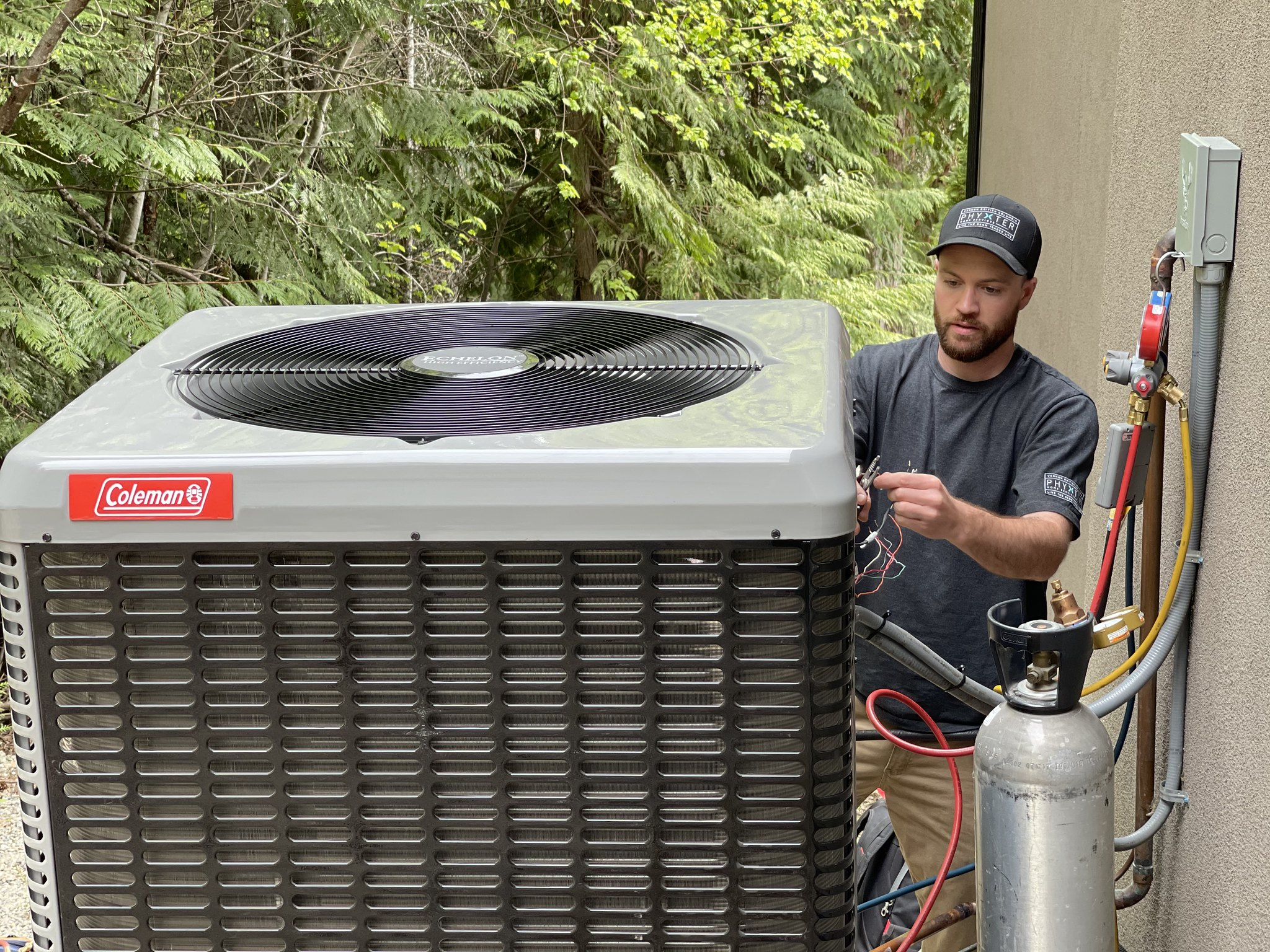Canada is known for its cold winters, but thanks to climate change, extreme heat is increasingly becoming a matter of life and death.
To cope, many Canadians turn to central air conditioners to cool their homes. A new report by multiple climate policy research groups says this is a missed opportunity to switch to heat pumps, which are more energy-efficient and can both heat and cool our homes.
Every week, 7,000 households install a central air conditioner when they could have put in a heat pump, according to a new report from the Canadian Climate Institute, Building Decarbonization Alliance, Efficiency Canada and the Greenhouse Institute.
“We could be saving money, people could have more comfortable homes and we could be cutting (greenhouse gas) emissions all at the same time if we were installing heat pumps instead of central air conditioners in Canada,” Alexander Gard-Murray, the report’s lead author, told Canada’s National Observer in a phone interview.
If the entire supply of new central air conditioners was replaced with heat pumps starting in 2025, it would mean cumulative energy bill savings of $10.4 billion across Canada by 2035. When the estimated $3.7-billion cost of buying and installing the heat pumps is added, the total value of energy bill savings is $6.7 billion.
The authors calculate in the year 2030, affected households would save an average of $349.
“It's a no-regrets policy,” said Gard-Murray. Despite regional differences in climate and the energy mix, this is either going to “help substantially” with your energy bills “or you're going to come out basically equal,” he added.
Between 2018 and 2022, ducted heat pump sales increased by 18 per cent, the authors write. However, 10 times more central air conditioners than heat pumps were purchased in 2022.
“This isn't a choice people get to make very often and it's usually a choice people have to make really quickly,” said Gard-Murray, director of the Greenhouse Institute. Central air conditioners tend to fail under stress at the “worst time,” like during a heat wave, for example. This forces people to make a quick decision based on what is in stock and what their contractor recommends, he said.
“If you put in a central air conditioner, then it's gonna last for 10, 15, maybe 20 years. It's not likely going to make financial sense for you to get a heat pump for another 10 to 15 years,” said Gard-Murray.
Low familiarity is another challenge to the widespread adoption of heat pumps: the system doesn’t exactly sound like something that can also cool your house, the report noted.
A not-yet-released Abacus Data poll found 49 per cent of 2,000 Canadian adults surveyed either haven't heard of heat pumps or aren't sure what they do. The survey, commissioned by Stand.earth, was conducted between June 22 and 27.
Last winter, Gard-Murray says his landlord’s furnace failed and before he could suggest a heat pump to them, they put a deposit down for a new furnace. Within 24 hours, the deposit was already down, he said.
“That's how narrow the window is,” said Gard-Murray. “Even if you have a heat pump evangelist living downstairs, you can miss the chance.”
The report explores what a market transformation to replace central AC with heat pumps would look like, assuming people will purchase the most basic heat pumps on the market and not receive any grants or funding from federal or provincial programs to cover the cost. Even using these conservative assumptions, “we still see these big benefits,” said Gard-Murray. The cumulative climate benefits from 2025 to 2035 came out to 19.6 million tonnes of carbon dioxide or an equivalent amount of greenhouse gases. That is equivalent to nearly 4,600,000 homes’ energy use for one year, according to Natural Resources Canada’s greenhouse gas calculator.
“If people buy even better models, specialized cold climate models, and they use government incentives to do so, we'll probably expect the benefits to be even bigger than what we projected,” said Gard-Murray. If governments continue to offer rebates, it is likely people will opt for higher-performance models, the report noted.
Natural Resources Canada has a $250-million program to help low- to middle-income households now heating their homes with oil make the switch to electric heat pumps. Eligible homeowners can receive up to $5,000 to purchase and install a new, cold-climate heat pump.
That grant can also be combined with the federal government’s existing greener homes grants of up to $5,000 to homeowners who complete energy-efficient home retrofits and another $600 towards the cost of a home energy assessment, which is required to receive the funding.
There are also interest-free loans of up to $40,000 for major home retrofits being offered by the federal government, which can help homeowners not only switch heating and cooling systems, but also make their home more airtight and energy efficient with new windows, insulation and more.
‘Spooked by the heat dome’
For Vancouver, B.C., resident Terre Satterfield, provincial and municipal rebates were key to her decision to get a heat pump in June 2022.
“At the time, I was a little spooked by the heat dome that had occurred in the year before — I have an elderly father,” Satterfield told Canada’s National Observer in a phone interview. The 2021 heat dome killed 619 people between June 25 and July 1, according to the BC Coroners Service. The following year, a review panel’s findings revealed almost all the deaths occurred indoors and 67 per cent were people aged 70 or older.
Satterfield looked at modifying the existing natural gas system to add air conditioning versus installing a heat pump and found “it was cheaper to change out the whole system with the rebate than it was to add cooling to the gas furnace.”
Thanks to the rebates, going the heat pump route was at least $2,000 cheaper than sticking with gas, she said. She was able to access CleanBC’s rebate as well as one offered by the City of Vancouver.
Had rebates not been available, Satterfield said she would have waited for the furnace to die and still might have ended up with a gas-dependent cooling system. “I didn't get the federal (rebate) because I didn't know that I had to do an energy audit beforehand,” she added.
Her advice to people considering heat pumps: hire a contractor who knows what type of proof is required for the different rebates being offered. A knowledgeable contractor can help you navigate the sometimes confusing rebate systems and ensure you have any photo proof or documentation needed to access grants.
“My total costs of heating have gone down,” said Satterfield, estimating that, overall, her gas bill is about $75 less per month and her electricity bill is about $50 more.
The most straightforward way to transform the market so heat pumps become the new central AC would be a national mandate that all central air conditioners sold in Canada also have heating capabilities, the report says. This approach would also help renters who can’t choose to undertake energy-efficient retrofits — their landlords would have to make the switch, which would help renters by lowering utility bills, Gard-Murray added.
Vancouver has a policy that effectively requires all new central air conditioners in detached one- or two-family homes be heat pumps. The federal government could also consider creating incentives for manufacturers and distributors to sell more heat pumps, in addition to using building codes and equipment requirements to accelerate the shift.
Natasha Bulowski / Local Journalism Initiative / Canada’s National Observer
Often missing in
Often missing in presentations about heat pumps is mention of ground source heat pumps (GSHP). They are expensive, but relatively cheap to operate. Air source heat pumps, although improved over the years, are not all that appropriate for certain stretches of winter, as in "northern" Ontario. In my case, I had holes drilled into rock to access the source of heat (1992). The unit needed replacing after nearly 27 years of use, which is still commendable. Not everyone can realistically utilize horizontal or vertical pipes to collect the heat, but GSHP should be at least a consideration.
In 2008 during a renovation
In 2008 during a renovation we replaced electric baseboard heating with a ground source geothermal system with heated flooring for most of the house. Over the years we've had minor problems with adjustments , recharging the antifreeze in the ground pipes, upgrading the pumps but no complaints about the performance. We did it mostly for the heating but what we did not anticipate was just how effective the AC function would become. At the same time we installed new water heaters and used one to recover residual heat from the geothermal system to preheat the water.
Don't know how much we have saved but we can't complain about the performance and rejoice in the little bit we have done to reduce our GHG footprint.
The library where I worked for many years installed ground source (vertical pipes) during renovations at two branches - after I retired. Both buildings, one large, one small, seem to be doing just fine. Ground Source is an excellent choice for larger commercial buildings.
One major consideration not
One major consideration not mentioned in these articles (this is not the first) is the cost of electrical upgrades to existing older houses. It's not cheap to upgrade from a 100 amp service to 200 amps in 100+ year old structures, and it all depends on the availability of additional power in the neighbourhood hydro grid which is often old too, a consideration as heat pumps and EVs appear in greater numbers and power demand goes up in heritage neighbourhoods.
One neighbour went all in and fully electrified during a major renovation, then had his gas line disconnected. He bought a Tesla on top of the heat pump, induction stove and on demand hot water heaters. He found his electrical bill soared more than anticipated, mainly attributable to the 14 cents per kWh surcharge on consumption above a certain ceiling. Otherwise, it's 10 cents. He decided to go solar with battery backup and uses Hydro only to top up the batteries when needed. We're talking about tens of thousands in costs that didn't present a reasonable payback period, though his house became perhaps the only zero emission household within a kilometre. Net metering will not make it worth the effort in BC after this year when BC Hydro will reduce the NM credit from 100% to 40%. The house now has lots of valuable physical equity, though, but that is financially irrelevant until you actually sell.
Building new is a different story and every home should have an adequate electrical energy supply to compensate for not connecting to gas or burning heating oil. Building codes are largely reflecting all this today. I suggest the energy systems should have a collective function that extends to entire neighbourhoods where non-profit subscriptions to district battery storage owned by residents and business can serve the common good. All transmission lines should be placed in underground conduits from Day One, an easy step given the shorter runs in new urban areas under construction. Even with an 85% or 90% NM credit where the utility keeps 10%-15%, the cost of installing rooftop solar will have a distinct payback period that should give close to 10 years of free power after the system cost is covered through savings, and where large-scale communal banks of batteries are used with everyone sharing the cost.
BC Hydro too often thinks it's god, but that misconception will be grounded (pun intended) if entire towns go off grid with their own self-contained battery storage-rooftop PV generation system, possibly backed by wind turbines on the neighbouring farms. A Hydro intertie could be provided and used strictly for emergency power, and my guess is that Hydro will need to tap independent battery-backed power producers more than the other way around, given the sheer number of outages in every storm caused by trees dropping branches on overhead wires.
Yes, we have grants at two or three levels, but they aren't universal when it comes to electrical upgrades.






Comments